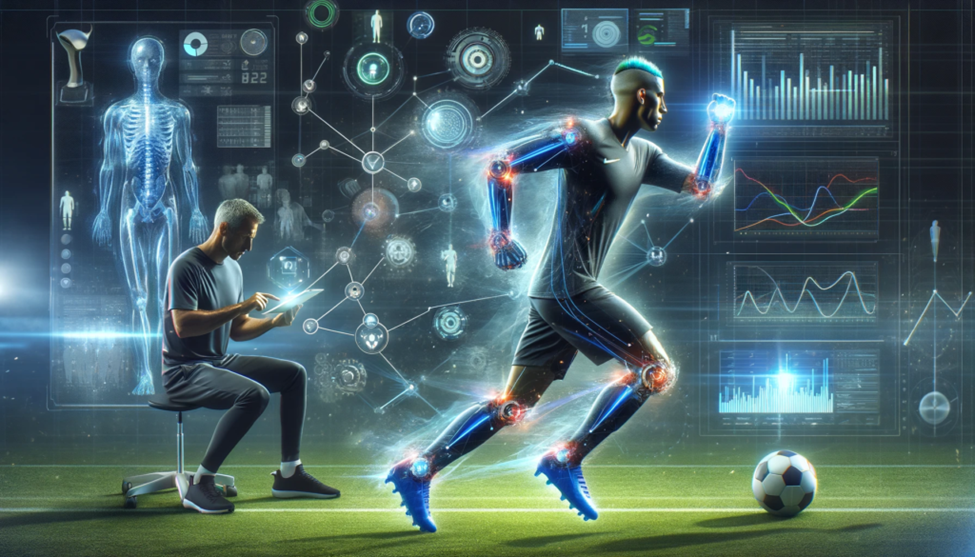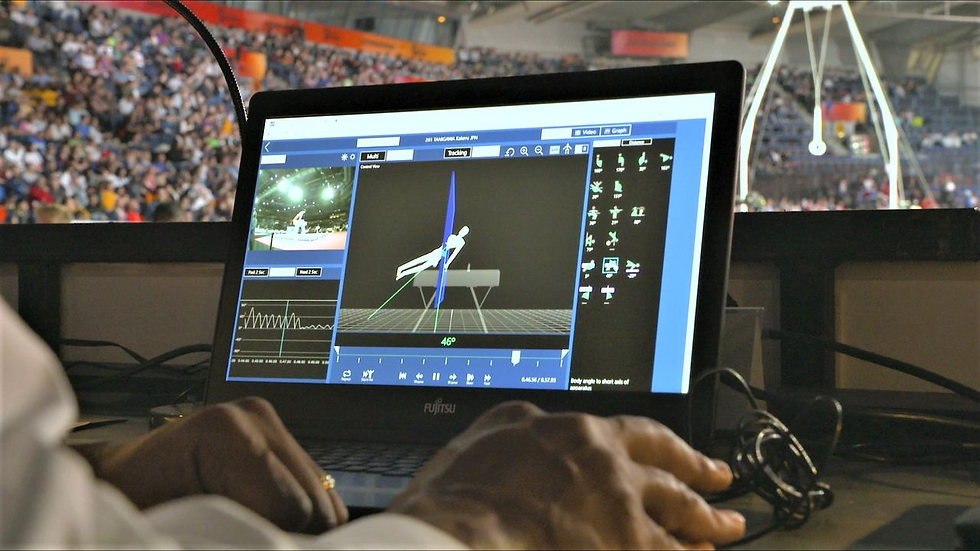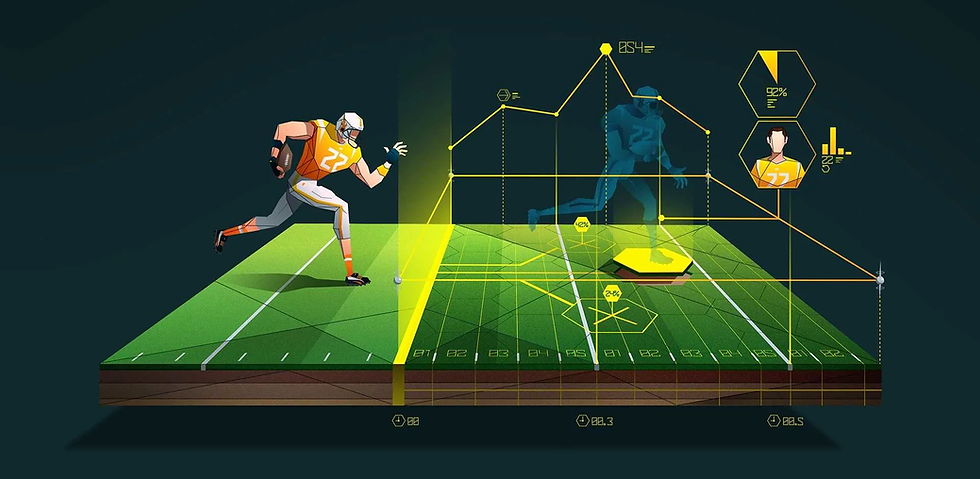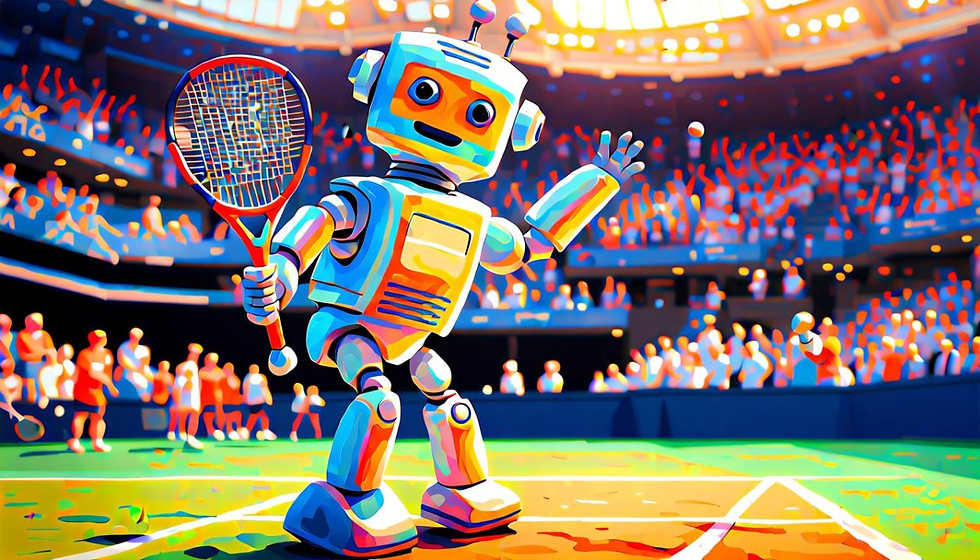Artificial Intelligence (AI) is revolutionizing various industries, and sports is no exception. Integrating AI into sports is transforming how athletes train, teams, strategize, and fans engage with their favorite sports. From enhancing performance analytics to providing personalized fan experiences, AI is shaping the future of sports.
This article delves into how AI enhances performance analytics and fan engagement, the technologies involved, and the potential challenges and opportunities.
The Role of AI in Performance Analytics
Data-Driven Training
AI has brought a data-driven approach to athletic training. Through wearable devices and sensors, vast amounts of data are collected on athletes' performance, including speed, heart rate, and fatigue levels. AI algorithms analyze this data in real time, providing insights into an athlete’s physical condition, strengths, and areas for improvement. Coaches can use this information to tailor training programs, optimize workouts, and reduce the risk of injury.
Predictive Analytics
AI-powered predictive analytics plays a crucial role in sports. By analyzing historical data, AI models can predict game results, player performance, and injury risks. Teams can use these predictions to make strategic decisions, such as which players to field in a game, how to allocate resources, or when to rest key players.
Biomechanical Analysis
AI also aids in biomechanical analysis by capturing and analyzing the movement of athletes. High-speed cameras and AI software can break down an athlete's movements to identify inefficiencies or potential injury risks. This level of analysis helps athletes refine their techniques and improve overall performance.
Tactical and Strategic Insights
AI can analyze vast amounts of game data, offering insights into tactics and strategies. By analyzing an opponent’s past games, AI can identify patterns, weaknesses, and tendencies, allowing teams to devise more effective game plans. This level of strategic analysis was previously impossible due to the sheer volume of data involved.
Technologies Behind AI in Sports
Machine Learning and Deep Learning
Machine learning (ML) and deep learning are at the core of AI applications in sports. These technologies enable the analysis of large datasets to identify patterns and make predictions. In sports, ML models can predict outcomes, optimize strategies, and personalize fan experiences.
Computer Vision
Computer vision is crucial for applications like biomechanical analysis and real-time performance tracking. It enables the extraction of meaningful data from video footage, which can be used to assess player movements, analyze game footage, and provide real-time feedback.
Natural Language Processing (NLP)
NLP is used in chatbots and virtual assistants to understand and respond to fan queries. It also plays a role in analyzing fan sentiment on social media, allowing sports organizations to gauge public opinion and respond accordingly.
Augmented Reality (AR) and Virtual Reality (VR)
AR and VR technologies, powered by AI, are transforming the fan experience. These technologies offer immersive experiences, such as virtual replays, interactive stats, and enhanced live game viewing.
Case Studies of AI in Sports
AI in Football (Soccer)
Football teams are increasingly using AI for tactical analysis, player scouting, and injury prevention. For example, AI-driven platforms can analyze game footage to provide insights into team formations, player positioning, and tactical adjustments. This information helps coaches make informed decisions during matches.
AI in Basketball
In basketball, AI is used for shot prediction, play analysis, and player development. AI models can predict the likelihood of a shot being successful based on factors such as player position, defender proximity, and shot history. Teams use these insights to optimize shooting strategies and improve player performance.
AI in Tennis
Tennis players and coaches use AI to analyze match data, such as serve patterns and shot placement. AI-powered platforms can provide real-time feedback during training sessions, helping players refine their techniques and strategies.
AI in Athletics
In track and field, AI is used to analyze biomechanical data, optimize training regimens, and reduce injury risks. For example, AI can analyze a sprinter's running form to identify inefficiencies and recommend adjustments.
In the men's 100-meter race at the 2024 Summer Olympics in Paris, France, the difference between first and last place was 0.12 seconds
The 0.12-second difference between first and last place in the men's 100-meter race at the 2024 Summer Olympics was detected using advanced AI-enhanced timing systems. AI technology played a crucial role in analyzing data from high-speed photo-finish cameras, electronic sensors, and laser systems at the finish line.
By processing this data in real-time, AI ensured accurate and precise measurements down to the thousandth of a second. This allowed officials to determine even the smallest differences in performance, ensuring fair and exact results for all athletes.
The Future of AI in Sports
AI-Driven Coaching Assistants
In the future, AI-driven coaching assistants could become a standard tool for teams and athletes. These virtual assistants would provide real-time insights, tactical suggestions, and personalized training programs, making coaching more precise and effective.
AI-Enhanced Recruitment and Scouting
AI will continue to enhance the recruitment and scouting process by identifying talent earlier and more accurately. AI-driven platforms could analyze vast amounts of player data from around the world, identifying prospects that human scouts might miss.
Ethical Considerations
As AI becomes more prevalent in sports, ethical considerations will become increasingly important. Issues such as data privacy, bias in AI algorithms, and the potential for AI to give certain teams an unfair advantage will need to be addressed through regulations and best practices.
The Integration of AI into Everyday Fan Experiences
AI will likely become an integral part of everyday fan experiences, from personalized content and interactions to immersive live game viewing. As AI technologies continue to advance, the possibilities for enhancing fan engagement will expand.
Can AI-assisted referees improve accuracy and fairness in sports decision-making?
AI-assisted referees have the potential to significantly improve accuracy and fairness in sports decision-making. Traditional refereeing relies on human judgment, which can be prone to error due to the fast-paced nature of many sports and the limitations of human perception. AI, with its ability to analyze data in real time, can assist referees by providing instant feedback and objective assessments.
For example, AI-powered systems can use computer vision to detect fouls, offsides, or boundary violations with a higher degree of precision than the human eye. This technology can review multiple camera angles simultaneously, ensuring that decisions are based on the most accurate information available. Additionally, AI can track player movements and predict potential rule violations before they happen, allowing referees to make more informed calls.
By reducing human error, AI-assisted referees can enhance the fairness of sports competitions. They provide consistency in decision-making, minimizing the influence of subjective bias or pressure from players and fans.
However, it is essential to strike a balance between AI assistance and human judgment, ensuring that technology complements rather than replaces the role of the referee. When used effectively, AI can lead to more accurate and fair outcomes in sports, enhancing the integrity of the game.
How does AI-driven fan engagement transform the sports viewing experience?
AI-driven fan engagement is revolutionizing the sports viewing experience by creating more personalized, interactive, and immersive encounters for fans. With AI, sports organizations can analyze vast amounts of data, including fan behavior, preferences, and social media interactions, to deliver tailored content that resonates with individual viewers.
For instance, AI can curate personalized highlights, real-time statistics, and predictive insights during live games, enhancing the viewer’s connection to the event. Fans can receive customized notifications and updates based on their favorite teams or players, making the experience more engaging and relevant.
Moreover, AI-powered chatbots and virtual assistants allow fans to interact with their favorite teams, access information, and participate in polls or quizzes during games, fostering a sense of community. Augmented reality (AR) and virtual reality (VR) experiences, driven by AI, also bring fans closer to the action by offering immersive environments that replicate the thrill of being in the stadium.
AI’s ability to analyze and respond to fan feedback in real-time further enhances engagement by continuously adapting and improving the content delivered. This transformation not only deepens the emotional connection between fans and their favorite sports but also opens up new revenue streams for sports organizations through targeted advertising and premium content offerings.
Can AI help detect and prevent doping in sports?
AI can play a crucial role in detecting and preventing doping in sports by analyzing complex data patterns and identifying anomalies that traditional methods might miss. Doping detection relies on monitoring biomarkers, drug use patterns, and physiological data, all of which generate large datasets. AI's ability to process and analyze this data quickly and accurately makes it an effective tool in the fight against doping.
Machine learning algorithms can be trained on historical data from doping cases to recognize patterns associated with drug use. For instance, AI can detect subtle changes in an athlete's biological passport, a record of blood values over time, which might indicate the use of performance-enhancing drugs. These algorithms can also analyze social media activity, medical records, and other non-traditional data sources to identify suspicious behavior.
Furthermore, AI can help predict and prevent doping by identifying athletes at higher risk of doping based on their performance metrics, psychological profiles, and other factors. This proactive approach allows sports organizations to intervene before doping occurs, potentially reducing the incidence of cheating.
While AI is a powerful tool, it is most effective when used alongside traditional methods and ethical considerations, ensuring that its implementation respects athletes' rights and maintains the integrity of sports.
How does AI-powered data analysis impact player recruitment and talent identification?
AI-powered data analysis has transformed player recruitment and talent identification in sports by providing deeper insights into player performance, potential, and fit within a team. Traditional scouting methods often rely on subjective observations and limited data, but AI can process vast amounts of information, including in-game statistics, physical attributes, and even social and psychological factors.
By analyzing patterns in a player's performance over time, AI can identify rising stars who may be overlooked by traditional scouts. It can also predict how a player might develop or adapt to different playing styles, helping teams make more informed decisions.
AI tools can also analyze video footage, breaking down a player's movements and decisions with precision. This level of detail allows recruiters to assess skills and tactics that may not be evident through statistics alone. Overall, AI enhances the accuracy and efficiency of talent identification, giving teams a competitive edge in player recruitment.
How might AI influence the future of sports broadcasting and storytelling?
AI is set to revolutionize sports broadcasting and storytelling by personalizing and enhancing the viewing experience. With AI-driven analytics, broadcasters can deliver real-time insights, stats, and predictions tailored to individual viewers, making the game more engaging and informative. AI can also generate highlight reels and summaries instantly, focusing on the most exciting moments based on audience preferences.
In storytelling, AI can create immersive narratives by analyzing data to identify compelling storylines, such as rivalries, player milestones, or historical comparisons. This allows for richer, more dynamic content that resonates with fans on a deeper level. Additionally, AI can enable interactive features, like virtual commentators or augmented reality overlays, further immersing viewers in the action.
As AI continues to evolve, it will not only enhance how we watch sports but also how stories around the games are told, making sports broadcasting more dynamic, personalized, and engaging.
CONCLUSION
AI is poised to become an integral part of the sports industry, driving significant advancements in performance analytics and fan engagement.
As AI technologies continue to evolve, their impact on sports will deepen, creating new opportunities for teams, athletes, and fans alike.
By embracing AI, the sports industry can unlock unprecedented levels of performance optimization and fan interaction, ensuring a future where sports are more engaging, data-driven, and inclusive than ever before.








great post
thanks for sharing😍